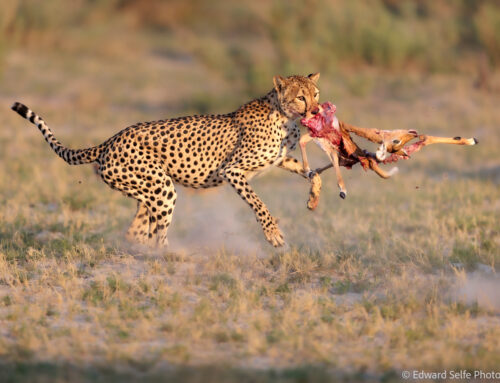I was recently talking to some of my guests about Mana Pools National Park since we could see it across the river when flying into the Lower Zambezi. While chatting about it, I was reminded of an amazing day that I experienced there back in 2019. I thought I would bring the story to the top of my wildlife blog in case anyone missed it the first time:
“The next day turned out to be one one of the most memorable of all my years on safari. When we stopped the vehicle, we heard the tell-tale sounds of wild dogs twittering in the distance so we decided to approach. Generally dogs make that high pitched twittering noise when they are socialising or when they are harassing prey. As we got closer, and I began to resolve the situation, I could barely believe what was unfolding in front of us….
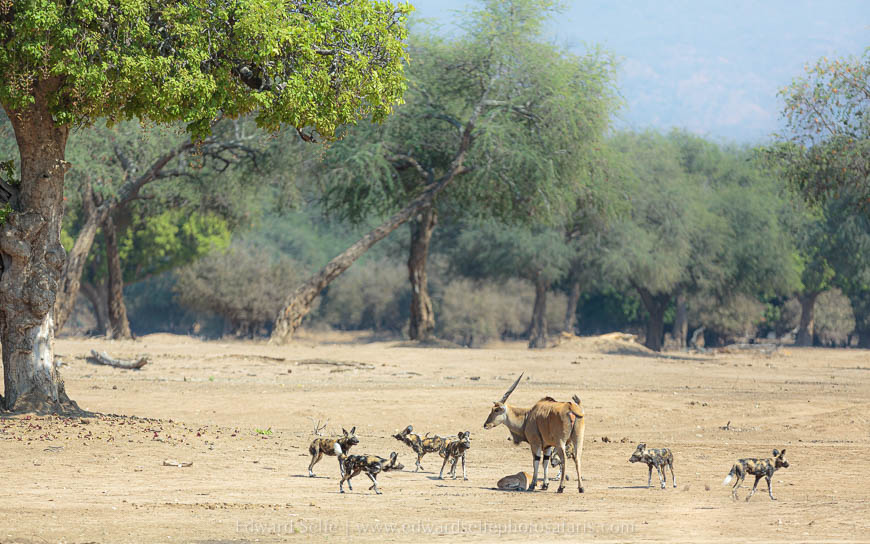
Yes, you’ve seen it right. Wild dogs surrounding an eland. But wait, is that an eland calf as well….?
We have little experience with eland in the South Luangwa, and certainly I’ve not seen them interacting with wild dogs so I knew that this was something special. But while I was excited, my over-whelming feeling was that this was an extremely sensitive situation. As far as we could assess, there was an eland cow, with her very young calf, surrounded by a pack of 9 wild dogs. This was equally thrilling, horrifying, exciting and confusing. How had the eland become separated from the protection of the herd? Were the dogs going for the calf or the cow? How long had this been going on?
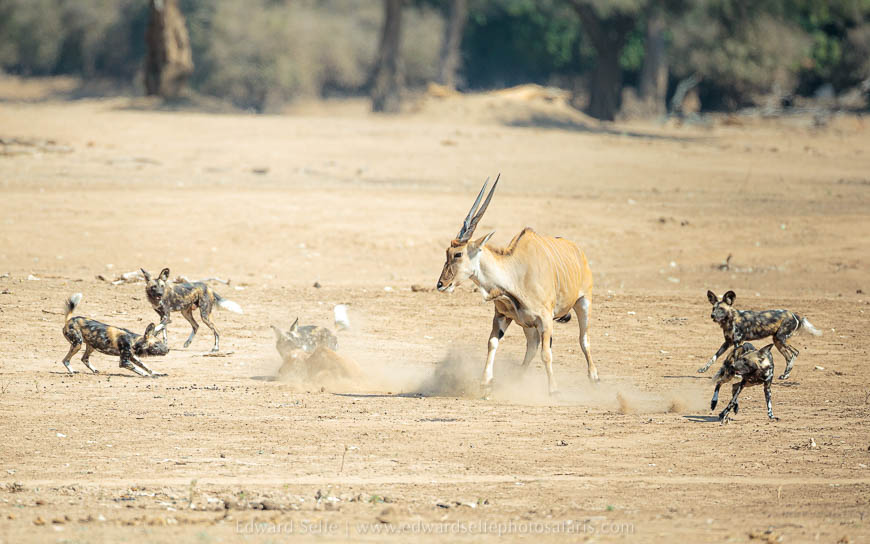
We stood in the sun exactly where we had arrived, watching from about 200m away as the dogs circled the eland and her calf. We could see that the dogs had already removed one of the calf’s ears. And when the female’s back was turned the dogs would rush in and grab the calf, but immediately drop it when the cow threatened the dogs with her horns.
I was also very concerned about our presence in this situation. While I had seen that animals took no notice of us up to this point, eland are always nervous creatures and I wanted to be absolutely sure that nothing we did would have an impact on this very sensitive situation. Of course we wanted to be closer and ideally with a lower angle to shoot the action, but first of all, we needed to make sure that we did so without any effect on the life-and-death situation in front of us.
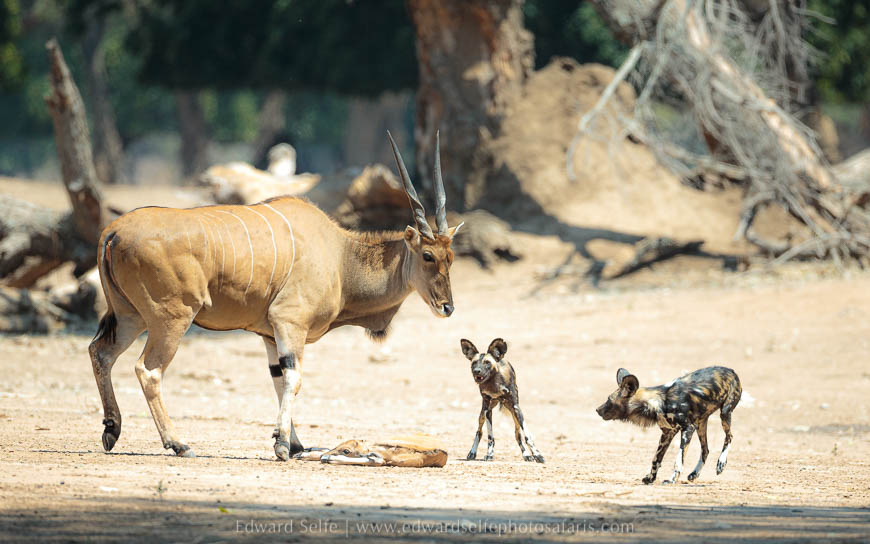
Carefully we settled ourselves in a suitable shady place where we could watch without affecting events. As we moved into position, the eland and the dogs watched us briefly. Once we stopped moving they returned to facing off against each other.
At that point, I had time to think about the circumstances that might have led up to this moment and to share some of these thoughts with my guests. Eland will usually separate from their herd to give birth, in line with the behaviour of many other antelope. This protects the calf in its very early days from the predators that are drawn to the movements of a large herd. The calf that we were watching was very young and still had a drying umbilical cord attached so was likely no more than a few days old. We suspected that the dogs had happened across the pair by chance and had shown extra interest in the calf due to its young age. The drought conditions prevailing in Mana Pools at the time would have affected the cow’s strength and she would likely have produced insufficient milk which might have been a contributing factor to the calf’s weakness. However, regardless of an animal’s condition, once dogs have identified their prey and begun to hunt, there is little that will stop their relentless pursuit.
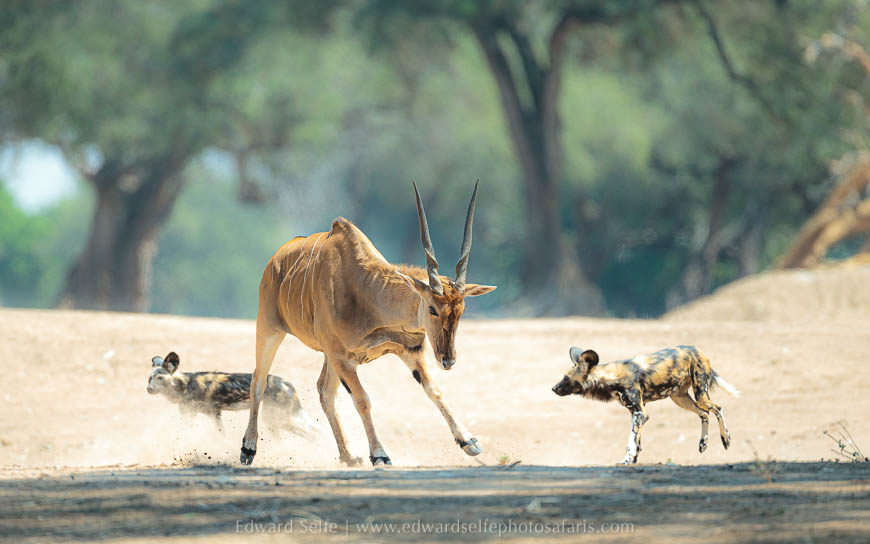
As time wore on, we became increasingly affected by the scene in front of us. Wild dogs are usually quick and fairly effective hunters. Of course there are exceptions, but a pack of 9 dogs would chase down and despatch a small antelope (such as this eland calf) in a few moments with minimal suffering. The irony was that the protection of the mother, with her large horns, was making it harder for the dogs to complete their kill. Of course, there was no doubting the cow’s good intentions; she was going to protect her calf whatever it took. But as the calf became weaker and weaker, it was clear that the dogs would prevail in the end. It was gruelling to watch the female’s attempts to protect her calf, particularly as we had the perspective to know that they were futile. While the dogs waited in the shade, she stood heroically over her calf, shading it from the sun. Had she walked away and left the calf, we assumed that the dogs would have ended its suffering in moments.
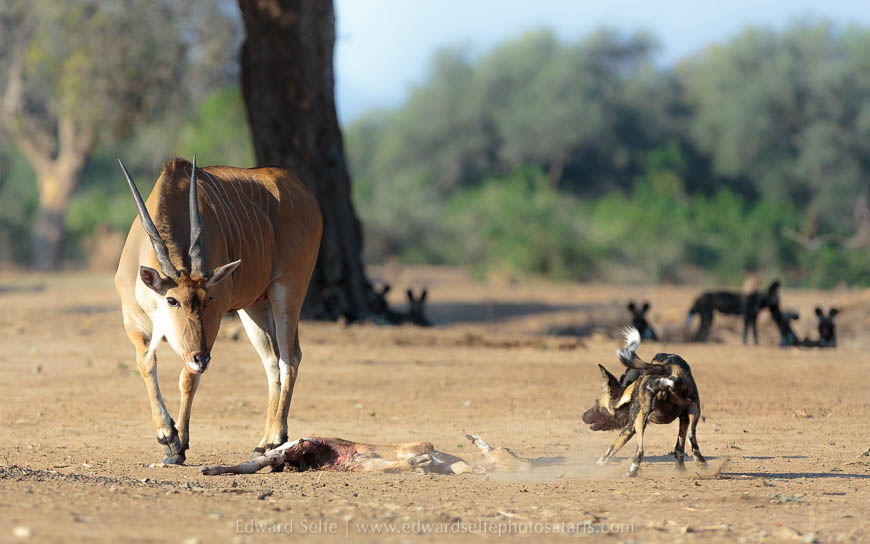
Should we have stayed to watch? We talked about this in depth during the time we were there. We were having no impact on the scene, which was my first concern. The eland stopped observing us soon after we arrived and the dogs never looked towards us. So, it was a question of whether we wanted to stay. At times we all felt sickened by the situation; we even talked about the ethics of moving closer, thereby scaring the eland cow away, and allowing the dogs to complete the kill. Of course, we were only talking hypothetically as we would never intervene in that way…but we wanted to, that’s for sure.
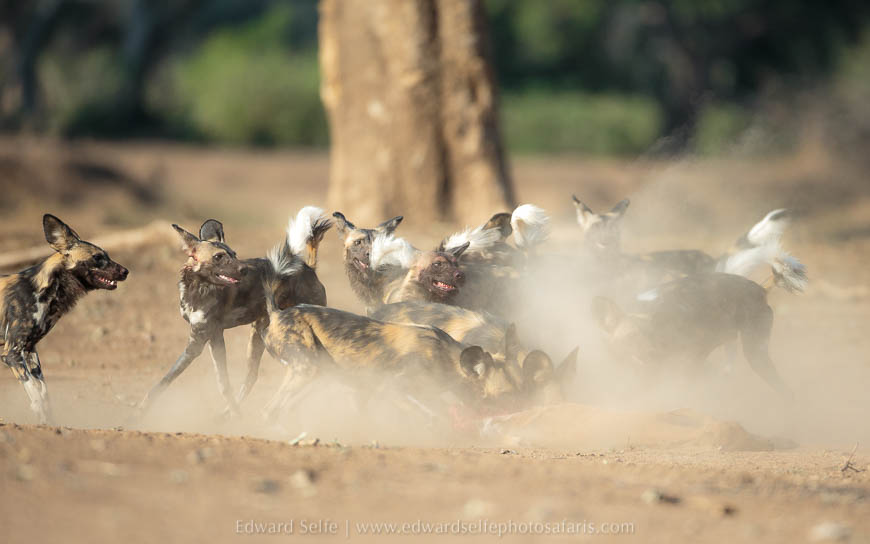
Then something changed. The eland became too hot standing in the sun and wandered unsteadily to the shade. As she reached the shade, the dogs rose and moved towards the calf. With their brutal but effective style the dogs moved to finish what they had begun some time before. It was awful to watch, but we had willed this to happen for some time as surely the calf’s suffering would be ended. But no, the cow was not surrendering yet… She stormed in, chasing the dogs away and began to lick the wounds of the calf, which by now were severe. We were horrified; the eland was simply doing her best to protect the calf and the dogs were trying their best to be as efficient as possible. And yet, the resulting cruelty of the scene was unimaginable.
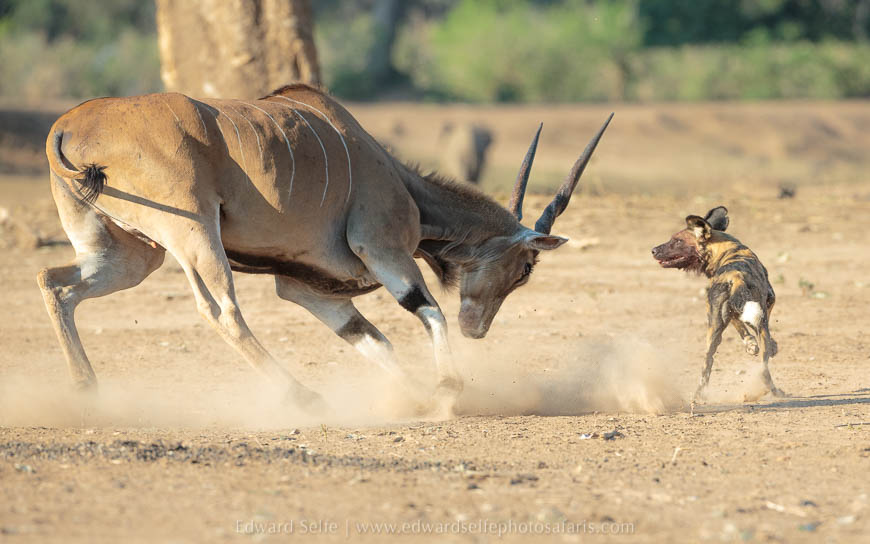
The cow licked the calf’s wounds for some time, before once again heading to the shade of the trees. This time the dogs were quicker, more decisive and the cow was slower to react; she was exhausted. In a few seconds, the dogs killed the calf and ended a savage course of events. To say we were relieved would have been an understatement. But we were also exhausted. Our role in these events is to record and document, or simply to watch. This was nature at its most unpleasant….and I think that is the right word. Dogs are much maligned for their cruelty, which is unfounded in my (fairly experienced) view. But without meaning to be cruel, the dogs had subjected this eland and her calf to terrible suffering.
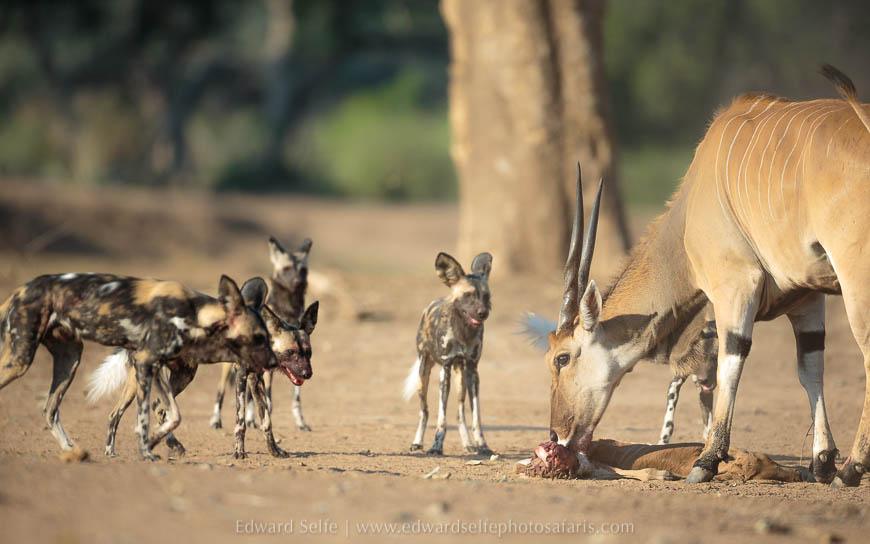
Once the calf had died, the fragility of the situation was much reduced. The dogs were not interested in the eland cow, and the cow was unlikely to endure any greater suffering that she already had. So we moved for the first time in about 3 hours, and chose a new position under a log pile with the light behind us. Even thought they had killed the calf, the eland cow had again chased the dogs off the carcass and was licking the wounds. But her actions then changed and she began to eat. I wasn’t sure at first, but studying carefully, I caught images of her taking flesh into her mouth and then chewing. This seemed pretty unusual but, in drought conditions, animals will often change their behaviour to survive. And in fact, eating a newborn calf is not a far stretch from eating the placenta after the birth. The more I thought about it, the more sense it made; out of a terrible situation, natural instinct was driving this eland to recover whatever nourishment she could from the calf that she had spent months growing inside her.
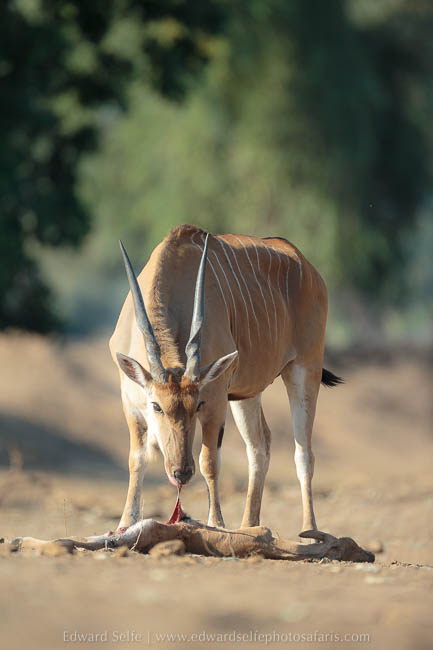
While we are not supposed to take sides in Nature – and I rarely do – it would be fair to say that we had felt more acutely the suffering of the eland, than the suffering of the dogs who were being denied a timely meal! But this latest development changed things. What had been a scene of unbearable cruelty was morphing into a scene of regeneration. The eland was taking charge of the situation and was recovering something from her loss. One could say that she was reclaiming her dignity, but having watched her protect that calf for hours in the midday sun, I would say that she retained that throughout. As I have mentioned before, the irony was that in being the best mother that Nature could design, the cow had inadvertently brought terrible suffering on her youngster. So while she might have been inadvertently cruel, she was certainly dignified throughout.
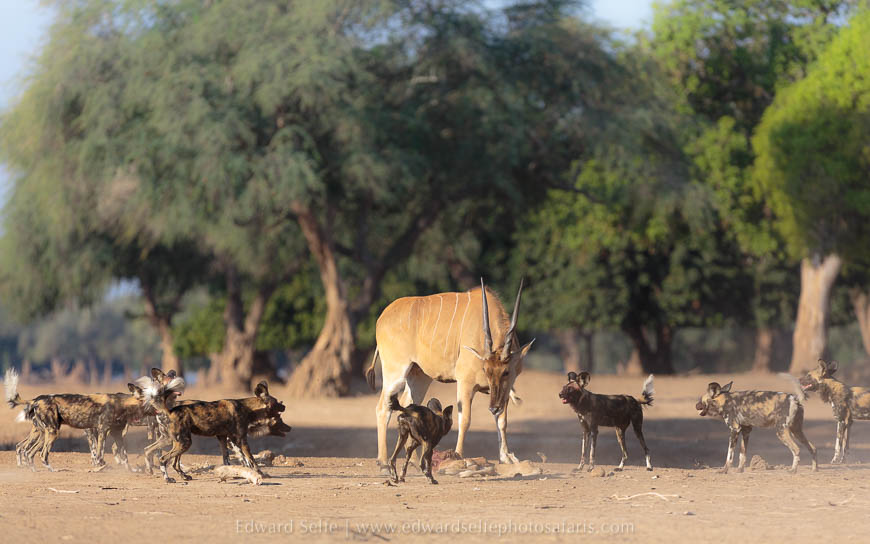
The dogs continued to circle and occasionally steal a small piece from the cow. At one stage, the exhausted predators and exhausted cow were feeding together on either end of the carcass. This was incredible viewing but, for me, the sighting had lost its intensity. The battle had been between the eland’s resolve to protect her calf and the dogs’ determination to feed; despite incredible resilience from the most majestic of all antelope, the dogs had won out in the end…..as we knew that they surely would.
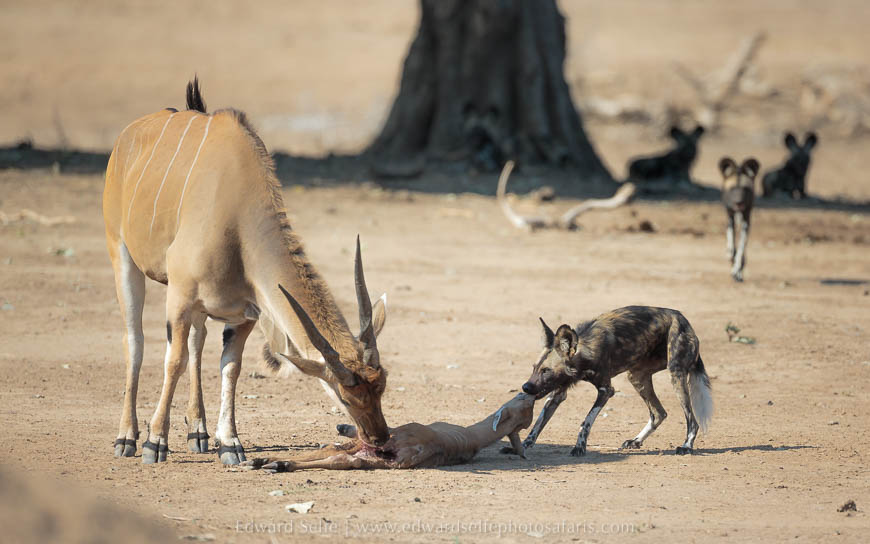
As the sun began to drop, the dogs captured the whole carcass from the exhausted antelope and fed hungrily as if they had caught it moments before. Only those of us who had been there throughout knew the full story and the heroism that had led to this moment. Kicking up dust and battling through the strong afternoon wind, the dogs dragged the carcass away and the eland eventually gave up her claim to the calf.
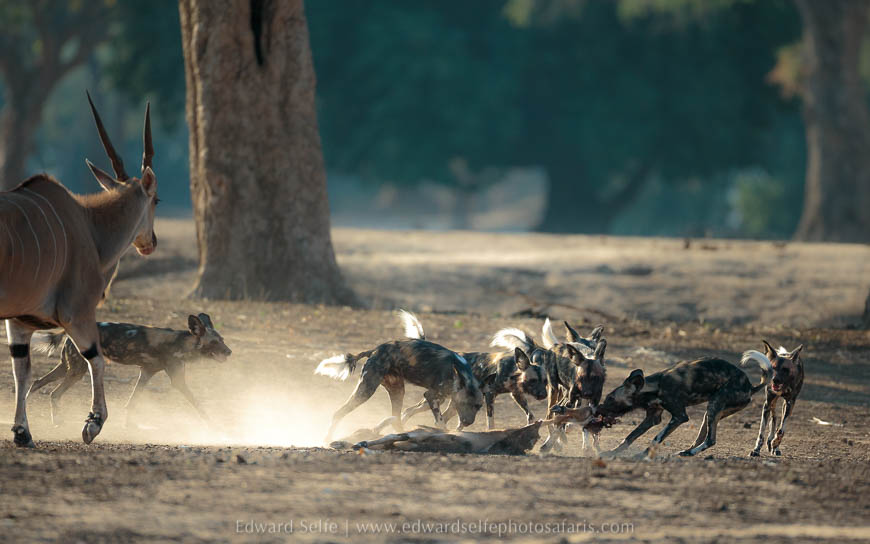
There are many memories from that day, but the strongest image for me is the sight of that beautiful eland cow standing defiantly over the body of her calf. That resonates very strongly with me, not for the emotional impact (thought it does) but because she represents the driving motivation at the very core of the natural world: the desire to survive, to breed and to ensure the survival of your offspring. This eland cow didn’t manage this time round, but she gave everything she could in trying.
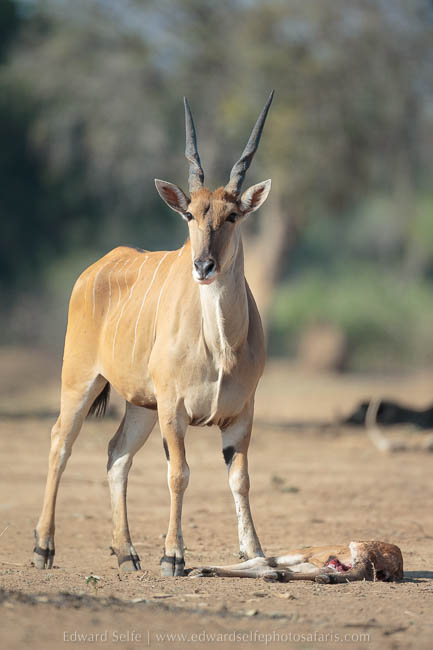
I took some video clips during the day, and compiled it into a short movie here. Take care, as this is tough to watch.
We left the wild dogs to finish the scraps of the eland carcass and started to head back to camp. As is often the case, there was more to be seen that day! As we got close to camp, lions were feeding on a buffalo carcass. It seemed that the buffalo might even have died from natural causes since there appeared to be little sign of a struggle; just another indication of the grip of the drought in that area.
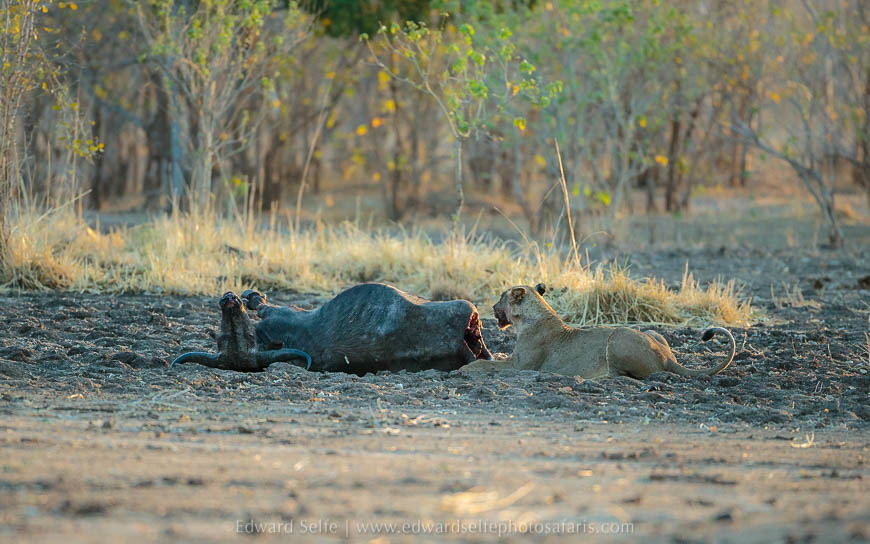
We walked from the vehicle towards the lions and found only one lion on the carcass. It seemed that the others had gone for water nearby. The lion wasn’t very comfortable with our presence, especially being alone as she was, so we left her to feed. Also, the light was dropping fast and we wanted to move out before it was too dark to see!
We had one more day in Mana Pools. What could possibly compete with the day before? Well, likely nothing, but in fact, we had one of the most picturesque days with beautiful sightings in the best Mana light. In the morning, it was buffalo at sunrise feeding on the endless sausage tree flowers that had fallen in the night.
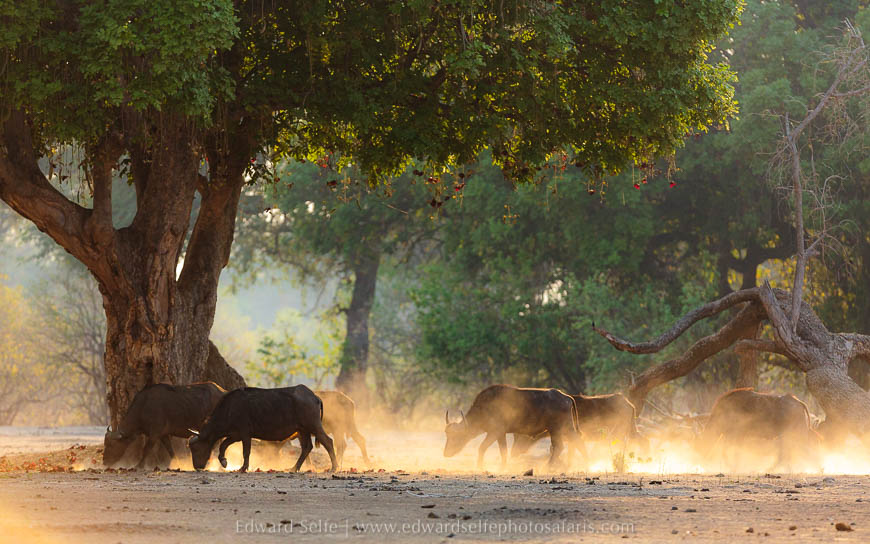
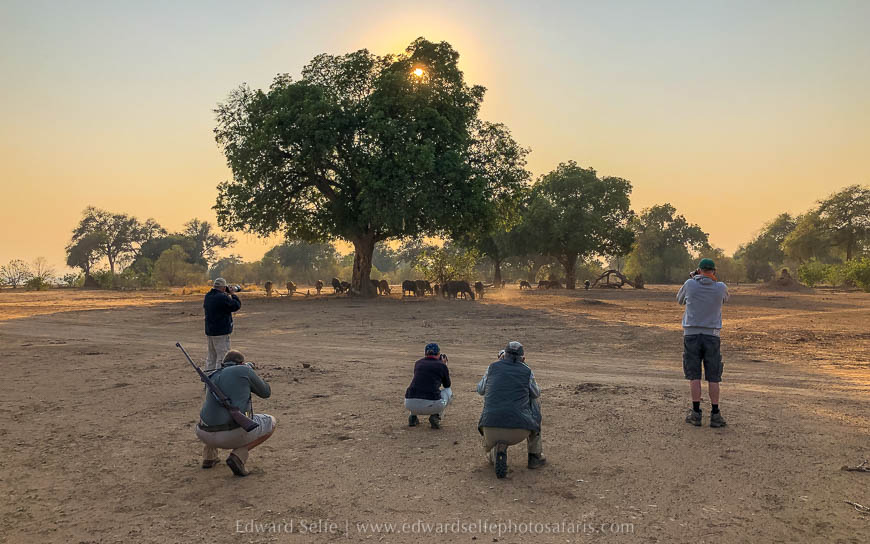
And in the afternoon, we went in search of elephants against the setting sun. And this was perhaps the most beautiful scene of the whole week….as the sun dropped low, before it disappeared behind the Zambian escarpment, a herd of elephants crossed a dusty plain towards us and gave us great silhouettes among the termite mounds. After all the savagery of the day before, it was a great way to end the trip.
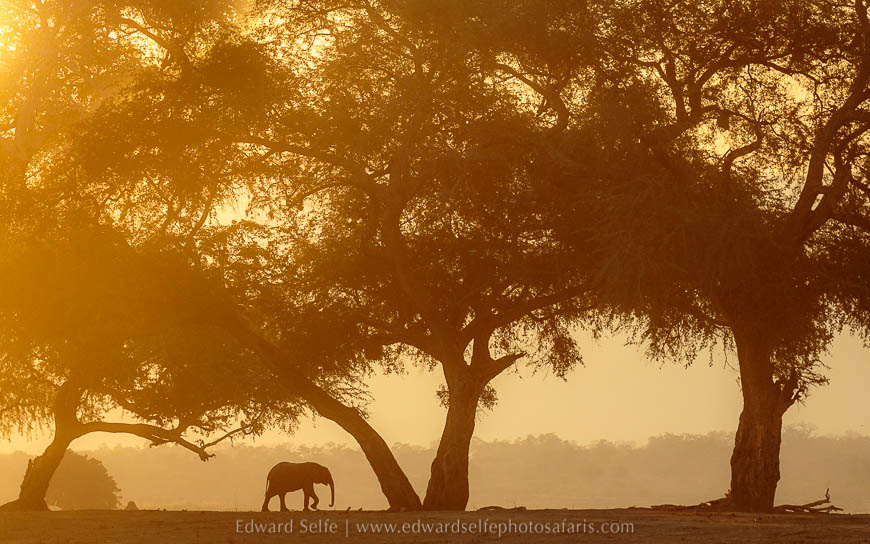
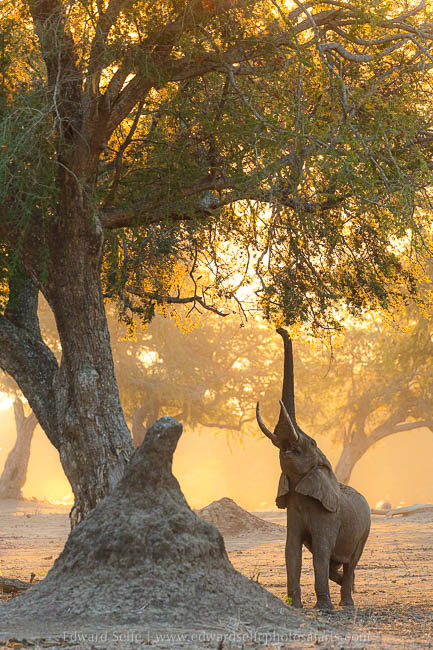
Perhaps my favourite shot of the trip.
My thanks to Kent, Gary, Carole and John for your company, great laughs and for sharing in the whole experience. Mana Pools is an immersive experience that is thrilling but also overwhelming, and it was great to see my guests throwing themselves at it in great style.
Mana Pools is a unique and unforgettable experience. I will be travelling there at least once each year and I think you should join me for the most incredible photo safari experience.”

